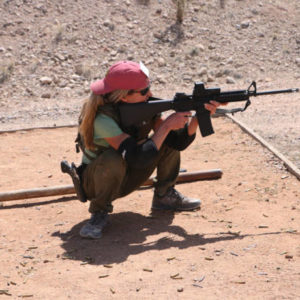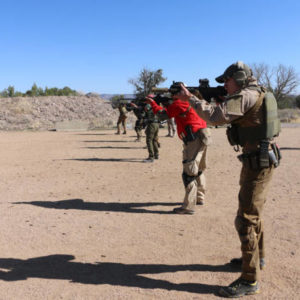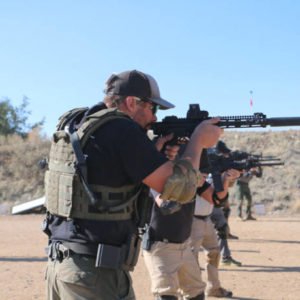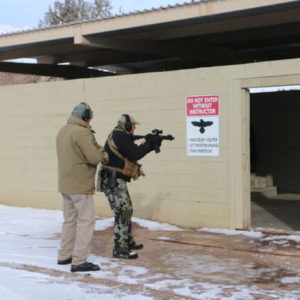BRAVE (Ballistic Response Against Violent Encounters) is a family of classes
developed to afford students a time and cost-effective way to receive training in a
variety of topics related to everyday self-protection issues.
While other BRAVE classes focus on pistol tactics, BRAVE Carbine provides
information in a variety of topics related to the deployment of the modern sporting rifle platform. BRAVE Carbine has the prerequisite requirement of Gunsite 250 pistol and 223 carbine classes. The class begins, like all Gunsite classes, with a classroom presentation of general safety principles and range safety rules.
The four cardinal rules of firearm safety presented
at every Gunsite class are:
1. All guns are always loaded
2. Never let the muzzle cover anything you
are not prepared to destroy
3. Keep your trigger finger straight until
your sights are on target
4. Be sure of your target.
 There has been discussion about the applicability of the above rules, but we believe
There has been discussion about the applicability of the above rules, but we believe
they have proven to provide a cornerstone for safety based on actionable information that reduces the likelihood of negligent actions by firearm handlers. Following the classroom presentation students proceed to the range and confirm their
rifle zero. We expect students to come to the class with a rifle zeroed for the distances they most expect to engage targets. As the school SOP, Gunsite uses the 50/200 yard zero. This allows the shooter to engage targets from zero to 200 yards by aiming at a single point and hitting from a maximum of approximately 2.5 inches low to 1.5 inches high depending on the distance to the target. Off set requires knowledge of the zero characteristics when precision is needed such as when needing to deliver a head shot. Students are given the opportunity to learn that skill through drills fired at various ranges starting at five yards and working back to 100 yards. The initial drills are designed to knock off any rust that may have developed in students’ weapon handling skills and allows instructors to get a feel for the present ability of students.

After four to five evolutions, the class will move back 10 to 15 yards at a time to the 100-yard line providing students an opportunity to determine how their zero affects impact on the target at each distance. It’s a simple drill that provides a lot of training opportunity. Students are responsible for keeping the system running by executing any necessary reloads and malfunction reduction on demand. Instructors provide guidance as needed. Since students have completed the basic 223 class before attending BRAVE Carbine, they are expected to know how to maintain the rifle with
minimal instruction.
Other drills will provide opportunities to review kneeling and prone positions, speed reloads and other necessary skills. Once the rust is knocked off, the class moves on to the tactical phase of training. Depending on the size of the class, students are divided into teams of four. Based on the fire team concept, students learn to maneuver as a team to address a variety of issues such as a mass attack, response to hostile fire, and deployments hostile fire, and deployments from vehicles. The tactics are designed to develop skills to respond to a criminal assault. Circumstances where the tactics might be employed would include natural or man made disasters when civil order is compromised, encounters in remote areas or anytime two or more trained individuals are assaulted by aggressive, armed criminals. Throughout the class, students are taught to establish a security element before maneuvering. One drill uses a method to withdraw from a crisis area with one two-man element setting a security position while the second two-man element withdraws a short distance. Once the maneuver element has reached their limit of movement, they will set security and enable the initial element to withdraw a specified distance. The bounding procedure is repeated until the team has removed itself from the crisis area.
Other instruction blocks include a forward movement, lateral movement and flanking
Training tourniquets, chest seals and bandages are provided for use by the team.
Once the injuries are treated, the team will effect a rescue and remove the injured party. As the rescue/removal element perform their assignment, the security element engages the renewed mass attack provided by Gunsite’s turning target system which can turn up to fifteen targets all at once, in random order or in blocks depending on the need of the class. Once the team has reached their linkup point, the exercise is terminated.
Next comes training for structure-based operations. Acting in two to four person elements, students learn how to approach, enter,
breach and clear structures based on a simple principle-based plan. The movements are intended for use in a situation where the police are not available or are delayed and lives are in immediate jeopardy. Once teams have “rescued” the innocents, they learn options to leave the structure or strongpoint in place and wait for the cavalry.
The students practice breaching or opening doors then sweeping the hole and 
After the teams have dialed in their new skills, they put those skills to use in focused live fire scenarios. As a two-man element, they rescue their “significant others” from a home invasion, then working at squad strength, extract themselves from a remote location while under fire and come to the aid of a group of friends being assaulted by an armed mob. All the while, students will be faced with challenges related to medical issues, broken down vehicles and limited ammunition and resources. To foster the ability to manage resources under duress, students can expect to face any of the evolutions with limited ammunition. Such a situation may come into play under any of the circumstances described. In the mass attack/ casualty evacuation drill, students could be limited to two magazines each and with minimal medical gear spread throughout the team. Adding such challenges fosters communication and cooperation above that needed to manage a single element shooting drill. Indeed, one of the primary purposes of BRAVE Carbine is to foster and develop the ability to communicate and manage crisis situations among groups of individuals. BRAVE Carbine takes the current limited availability of ammunition and uses that issue as a training opportunity. Using the concept of applying BRAVE Carbine tactics in remote areas or during the aftermath of a disaster, students are taught how to make the most of available resources.
During all exercises, students shoot what is needed without wasting ammunition. No one is going to bring more ammo, water or medical supplies to you so you better make the most of what you have. BRAVE Carbine encourages students to improvise and get the most out of every piece of equipment. Instructors will limit the number of magazines each team member can carry at times forcing team members to communicate and share resources as needed. Students must practice talking to each other to keep the team moving and operating efficiently. BRAVE Carbine requires students to stay aware of team mates’ status and condition and assist in keeping their team mates in the fight.
Throughout the class, instructors make suggestions on efficient communications and resource management between team members to maximize effectiveness. The team-based skills presented in BRAVE Carbine are a foundation for all team tactics. The skill sets students learn can be executed on a macro or micro level depending on the situation. Although the class is centered around the concept of a four-to-eight-man team, the tactics can be employed by a team consisting of as little as two people. The numbers change, but the principles remain the same. Understanding the dynamics of team integration can make even the smallest element a formidable defensive force.
BIO
Bob Whaley (www.Gunsite.com) is a retired St. Louis County Police lieutenant. He spent 15 years assigned to his department’s Tactical Operations Unit (SWAT). Other assignments included: patrol, intelligence and crimes against property. Bob has received training from and holds certifications in a variety of tactical applications and weapons platforms. He attended his first Gunsite class in 1989and became a staff instructor in 2005.


